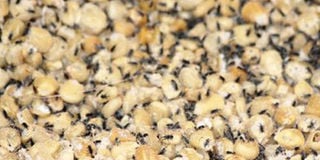Scientists develop research platform to fight aflatoxin

Researchers say spreading maize on the ground increases its contact with the soil, where the fungus that produces aflatoxins resides.
What you need to know:
- Seeing the threat to food security as a result of the damage caused by aflatoxin, scientists in East Africa have developed ways of combating the problem.
- He said under the umbrella of Bioscience, East and Central Africa (BECA), the Capacity and Action for Aflatoxin Reduction in Eastern Africa platform has been formed.
Maize, a staple food for over 100 million people in East Africa, is under threat due to its susceptibility to moulds that grow in nuts and seeds.
This is the toxic chemical produced by a fungus that is hazardous when eaten generally referred as aflatoxin.
It can cause cancer, suppress immune systems, reduce nutrient absorption, and stunt the growth of infants.
Seeing the threat to food security as a result of the damage caused by aflatoxin, scientists in East Africa have developed ways of combating the problem.
“We have teamed up to improve nutritional status and food safety in East Africa as well as increase capacity to detect and reduce the presence of aflatoxin in the food supply chain,” senior scientist Jagger Harvey told Xinhua in Nairobi.
He said under the umbrella of Bioscience, East and Central Africa (BECA), the Capacity and Action for Aflatoxin Reduction in Eastern Africa platform has been formed.
“The platform has provided researchers with new research tools and capacity to help fight the scourge of aflatoxin,” he added.
AFLATOXIN RISK MAPS
Dr Harvey said the project has led to the production of aflatoxin risk maps across Kenya and Tanzania to serve as tools to visualise its risk.
“We have also adopted ICT-based modelling tools that could soon predict where aflatoxin risks are emerging as the farming season comes towards harvest,” he said, adding that the project was also keen on developing new maize varieties for Kenya and Tanzania to help save farmers from perennial losses.
The platform is funded by the Australian Government to develop cost-effective methods of detecting aflatoxin contamination and develop and deploy a range of tools to reduce it.
“The multi-disciplinary five-country (Kenya, Tanzania, Burundi, Rwanda, Uganda, and Ethiopia) team now screens maize germ plasm for aflatoxin susceptibility levels,” said Dr Harvey.
The BECA laboratory that is based at the International Livestock Research Institute (ILRI) is equipped with the latest diagnostic technologies for use by African scientists who are conducting research on agricultural challenges.
The initiative is currently collaborating with the Partnership for Aflatoxin Control in Africa and other regional bodies in contributing to the development of policies to help improve food safety and trade in the continent.
“We are going to test on-farm interventions next year to help millions of farmers who rely on maize in Kenya and Tanzania,” Dr Harvey said.
According to ILRI director-general Jimmy Smith, even though progress is being made, research still needs to be done to help eradicate the problem as it poses a big problem to farmers and also denies consumers their favourite staple food.





